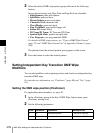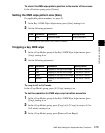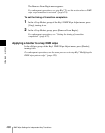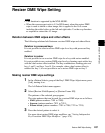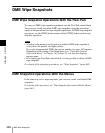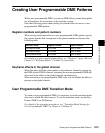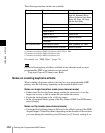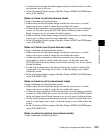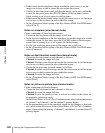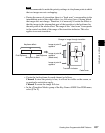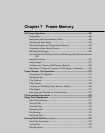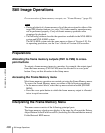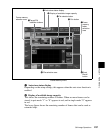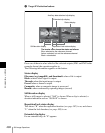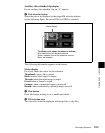
486
Creating User Programmable DME Patterns
Chapter 6 DME Wipes
• Either create the first keyframe image outside the screen area, or set the
image size to zero so that it cannot be seen within the screen.
• Create the first transition to end such that the image can be seen within the
screen. At this point, press the [PAUSE] button in the keyframe control
block, turning it on, to set a pause for the keyframe.
• Either create the last keyframe image outside the screen area, or set the image
size to zero so that it cannot be seen within the screen.
• In the <Transition Mode> group of the Key Frame >DME User PGM menu,
select [P In P].
Notes on compress (one-channel mode)
Create a minimum of three keyframe points.
• Create the first keyframe with the image at full size.
• In the state at completion of the first transition, create the image to be visible
within the screen. At this time, press the [PAUSE] button in the keyframe
control block, turning it on, to set a pause for the keyframe.
• For the last keyframe, once again set the image size to full size.
• In the <Transition Mode> group of the Key Frame >DME User PGM menu,
select [Compress].
Notes on dual transition mode (two-channel mode)
• Create the first keyframe for each channel as follows.
Channel 1: create the image full-size.
Channel 2: either create the image outside the screen area, or set the image
size to zero so that it cannot be seen within the screen.
• Create the last keyframe for each channel as follows.
Channel 1: either create the image outside the screen area, or set the image
size to zero so that it cannot be seen within the screen.
Channel 2: create the image full-size.
• In the <Transition Mode> group of the Key Frame >DME User PGM menu,
select [Dual].
Notes on picture-in-picture (two-channel mode)
Create a minimum of three keyframes.
• Create the first keyframe for each channel as follows.
Channel 1: create the image full-size.
Channel 2: since the priority is low, it will not be visible on the screen, so
no particular restrictions apply.
In the Global Effect >Ch1 to Ch4 >Combiner menu, when setting the priority
of channel 1 and channel 2, set the channel 1 priority higher.
• In the intermediate part of the transition, create the two images so that both
are visible within the screen. In the Global Effect >Ch1 to Ch4 >Combiner
menu, when setting the priority of channel 1 and channel 2, set the channel 2
priority higher.



